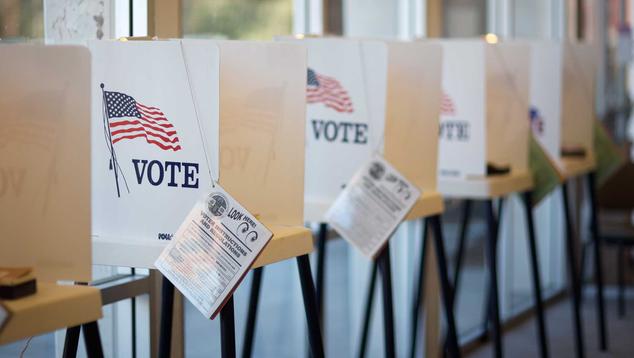Story Highlights
- President's party usually loses seats in midterm elections
- All key national mood indicators well below historical averages
- Party of unpopular presidents has lost an average of 37 House seats
WASHINGTON, D.C. -- With less than five months to go before voters elect all members of the House of Representatives and one-third of the Senate, the current Democratic congressional majority is facing an extremely unfavorable election environment.
The party of the president typically loses U.S. House seats in midterm elections -- an average of 23 since 1974. However, 2022 is not shaping up to be an average year. Rather, as of May, Gallup finds presidential job approval and three other key national mood indicators well below the historical averages measured in past midterm election years. On their own, those numbers would all predict a greater-than-average loss of seats for the Democratic Party this fall.
Gallup's latest data, from a May 2-22 survey, finds 41% of Americans approving of the job President Joe Biden is doing, 18% approving of the job Congress is doing, 16% satisfied with the way things are going in the U.S., and a 32-percentage-point deficit in positive (14%) versus negative (46%) ratings of current economic conditions. Each of those metrics is at least 10 points lower than the historical average at the time of past midterm elections, and most are on pace to be the worst of such readings.
The following sections of this report discuss how each of these four polling indicators, as well as party affiliation, has related to midterm election outcomes historically.
President Biden Job Approval Rating
Midterm elections are widely seen as a referendum on the incumbent president, and this is justified by the high correspondence between overall job approval and seat loss for the president's party. Given this, congressional seat losses for unpopular presidents' parties have been above average historically, averaging 37 since 1946.
Biden's current 41% approval rating puts him in the lower tier of all prior presidents' job approval ratings taken just before past midterm elections. Biden currently has the same approval rating that Donald Trump did at the time of the 2018 elections, when the GOP lost 40 House seats, and similar to Ronald Reagan's 42% in October 1982, before the Republicans lost 26 seats. Only one president, George W. Bush, had a lower rating than Biden does today, and his 38% rating in November 2006 was associated with a 30-seat loss.
Biden's fellow Democrats Bill Clinton and Barack Obama lost an even larger number of House seats in 1994 and 2010, respectively, with slightly higher approval ratings than Biden has now. Those steeper losses reflect the relatively large number of House seats held by Democrats going into those elections in addition to the president's unpopularity. The Democratic Party lost fewer seats in Obama's second midterm in 2014 when Obama was no more popular than in his first midterm four years earlier, but Democrats were defending fewer seats.
In the few elections where the president's party has gained seats (1998 and 2002) or lost a small number of seats (1986 and 1990), the incumbent president has been broadly popular, with approval ratings well above 50%. The exception was 1974, with Gerald Ford's 54% job approval more reflective of his honeymoon period in the months after he took office following Richard Nixon's resignation in August of that year. The GOP's 43-seat loss was likely tied to Nixon's unpopularity (24% approval in his last rating) stemming from the Watergate scandal that led to his resignation.
While Biden's job approval rating could improve by November, putting his party in a less precarious position, he would be bucking the trend for second-year presidents. Historically, presidents' job approval ratings have rarely improved in the last few months before their first midterms.
Democrats currently hold 220 seats in the House, just two above the number needed for a majority, and far fewer than the 250-plus they held before the Republican wave elections of 1994 and 2010. This relatively low seat exposure could help to check Democratic losses, as occurred in 2014.
Congressional Job Approval Rating
The 18% of Americans who approve of the job Congress is doing would be the lowest Gallup has measured in a midterm election if it holds at that level through the fall. However, it would not be much lower than the 20% to 21% approval ratings for Congress at the time of the past three midterm elections.
Americans' view of the job Congress is doing is also broadly predictive of how the president's party -- if not also the majority party in Congress -- will perform in the midterms.
In 1994, 2010 and 2018 -- all years when Congress' approval rating was between 21% and 23% and the president's party was in the majority -- the incumbent party lost between 40 and 63 House seats. In 2014, even with approval of Congress at 20%, the Democratic Party lost only 13 seats -- again explained by Democrats' weak starting position that year when House Republicans were in the majority.
In years when congressional approval was significantly higher, the president's party suffered minimal losses or even gained seats.
U.S. Satisfaction
Americans' satisfaction with the way things are going in the U.S. is also on pace to be the worst it has been in a midterm election year. The 16% currently satisfied is six points lower than the prior midterm low -- 22% in 2010.
Satisfaction relates to midterm House seat loss in a similar way as the job approval variables, with greater losses tending to happen in elections when satisfaction is low -- such as in 1982 (24%), 1994 (30%) and 2010 (22%) -- and more minimal losses or gains for the president's party in years when satisfaction is high, including 1986 (58%), 1998 (60%) and 2002 (48%).
Ratings of the Economy
Gallup has a shorter history of measuring Americans' perceptions of current U.S. economic conditions, dating back to the early 1990s. Since that time, Americans' views of the economy during midterm election years have only ever been similarly bad as now once before -- in 2010, when net ratings of economic conditions were -31.
Economic ratings tend to be less strongly related to midterm election outcomes than other mood indicators are, though views of the economy certainly influence how Americans rate the job that political leaders are doing and whether they are satisfied with the way things are going in the country.
Positive evaluations of the economy in 2006 and 2018 were not enough to overcome weak job approval ratings for Presidents Bush and Trump, respectively, and for Congress, suggesting political leaders were being evaluated on factors besides the economy. But even if the economy is less correlated with midterm election outcomes, the fact that Americans view it negatively this year is just one more issue that does not reflect favorably on the governing Democratic Party.
Party Affiliation
Vote choices in elections are strongly tied to a voter's political leanings. Party affiliation has been a good indicator of midterm election outcomes in the past because it either related to the partisanship of the electorate or was a harbinger of how people would vote.
On average over the past three months, Americans have been equally likely to identify politically as Republicans or say they are independents who lean toward the Republican Party (45%) as to identify as Democrats or to lean Democratic (45%).
While the parties appear, then, to be on equal footing heading into the midterms, the figures are generally a better sign for the Republican Party than the Democratic Party for two key reasons:
- First, historically, Democrats usually have an advantage on this measure of party affiliation. For example, in 2021, Democrats had a three-point advantage (though the numbers varied greatly over the course of the year), which is typical.
- Second, Republican voters usually turn out at higher rates than Democratic voters do. If usual turnout patterns hold, and partisanship among all national adults is even, then the electorate will have more Republican identifiers and leaners than Democratic ones.
There were also even splits in party affiliation in 1994, 2002, 2010, 2014 and 2018 election years, and all but one were good years for Republican candidates. The major exception was 2018, a year in which the parties were fairly evenly matched but Democrats did better in the elections, perhaps because of Trump's unpopularity and the unusually high turnout that year.
By contrast, in years when the Democratic Party had sizable advantages on party identification, like in 1998 and 2006, Democrats picked up seats in Congress.
Implications
Americans' dour evaluations of the president, Congress, the economy and direction of the country all suggest that the typical pattern by which the president's party loses seats in midterm elections will hold this year. While Republicans need to only pick up five seats in the House to take the majority in that chamber (assuming the vacant seats formerly held by Republicans stay with the party), the national mood is such that 2022 has the potential to be a wave election for the Republican Party and the GOP could have a more comfortable governing majority.
At the same time, the relatively slim majority enjoyed by House Democrats should shield the party from losses in the upper range of what's possible when presidential approval is in the low 40s and less than a quarter of Americans are satisfied with the state of the nation.
While it is unclear whether policy issues can eclipse presidential performance or the national mood as midterm election voting factors, Democrats may benefit politically from the Supreme Court overturning Roe v. Wade and Republican opposition to gun control measures in the wake of a series of mass shootings. Recent Gallup data suggest abortion will be a more important voting factor this year than it usually is in U.S. elections, more so among those who support rather than oppose legalized abortion. Also, even before the mass shootings, the majority of Americans expressed dissatisfaction with U.S. gun laws and favored enacting stricter laws. On the other hand, further increases in gas prices or renewed focus on the border crisis could compound Democrats' problems in November.
Regardless of what issues might drive voter behavior, unless Americans' opinions of the job Biden is doing and the state of the nation improve over the next five months, the Democratic Party may face a situation similar to 1994 and 2010 when it suffered major losses in its presidents' first midterms but regrouped in time to win the presidential election two years later.
To stay up to date with the latest Gallup News insights and updates, follow us on Twitter.
Learn more about how the Gallup Poll Social Series works.




